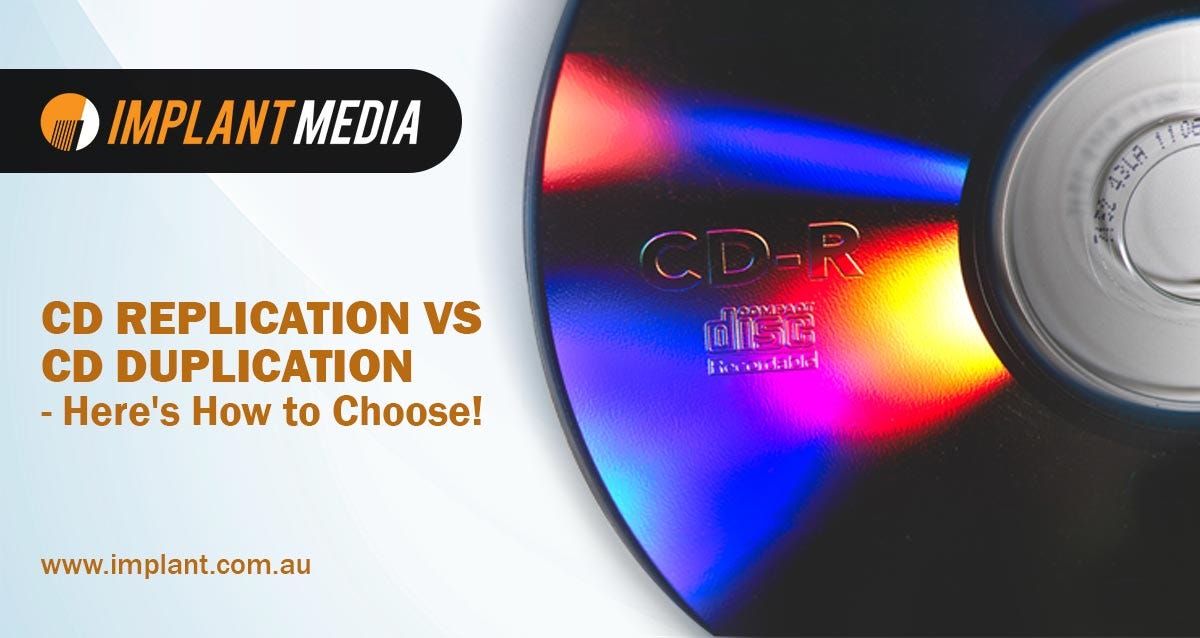CD Replication vs CD Duplication: Which is Better?

As a CD, DVD & Blu-Ray duplication and replication services provider, we get asked “CD Replication vs CD Duplication: Which is Better?” a lot. We decided to answer it and clear all of your doubts once and for all by looking at the difference between CD duplication and replication.
Let’s dig into the topic systematically and understand what CD/DVD/Blue-ray duplication or replication is and finally compare CD replication vs CD duplication, their benefits and which to choose and when.
Although the terms duplication & replication seem to mean the same thing, as a CD duplication company and a CD replication company, we can assure you that it is not the same.
What is CD replication?
CD replication, Australia, where Implant is located and anywhere else in the world, use CD moulding machines to manufacture the Compact Discs (CDs) or Digital Versatile Discs (DVDs) and involves a process that begins from scratch.
The process of CD replication involves the following:
Glass Master Preparation: The glass master is prepared in a cleanroom to ensure it is less susceptible to contaminants and uses a glass substrate to carry the CD master image with a steel hub on a side to facilitate handling, and one side is polished till it is smoothened
Glass Master Coating: This process includes rinsing the glass blank with a solvent and then applying photoresist or dye-polymer as per the mastering process.
Transferring Digital Data: The laser beam recorder is used to write on the master with deep blue or ultraviolet laser. Depending on the light-sensitive photoresist used, it undergoes a chemical reaction and is soaked in a developer solution.
Post-mastering Metalization: The nickel vapour on a rotating glass master is deposited, and after ensuring the coverage passes the inspection, it is moved to the next step.
Electroforming: The metalized master is lowered in an electroforming solution with the data side facing outwards. The process enables readying the glass master and toughening it for use in the injection moulding equipment.
Injection of Polycarbonate: The moulded “disc” is created using clear polycarbonate pellets, is melted in the barrels via the injection chamber and cooled with running water to solidify into moulded discs, which are removed with vacuum handling.
Sputtering: By the previous stage, the discs contain the necessary data, and to make it playable, the discs pass, a single copy at a time, into the metallizer to add a reflective surface made up of an alloy of aluminium and other metals in a small amount.
Lacquer Protection: The metalized layer is provided with a UV curable lacquer coat treated under a high-intensity UV lamp. It provides a surface for a label generally screen printed or offset printed.
Artwork Printing: With the ready artwork specs in printable PDFs or with the aid of a graphic designer creating one from scratch and then move onto label printing with the custom design.
Now that we have understood what CD replication is and the entire process let’s understand CD duplication.
What is CD Duplication?
CD duplication is a process where you begin with an actual existing CD, referred to as the master disk. Using a sophisticated, automated process, the burning of CDs as done in a home computer is accelerated and duplicated onto a CD-ROM of your choice.
The artwork printing, in this case, can be printed using high-resolution inkjet printers or get thermal print black text onto shiny, silver discs.
Looking at the simplified process involved in CD duplication, it seems like it is profitable to go with it than CD replication. If that were the case, then the “CD Replication vs CD Duplication: Which is Better?” question could have been answered with CD duplication without much thought. But that is not the case, and the reason behind it is discussed in the next section.
CD Replication vs CD Duplication — How to Choose Between the Two?

Choosing CD Replication over CD Duplication and vice-versa depends on multiple factors that decide the duration/cost of the project.
The packaging
Based on the packaging and the quantity required for your CDs/DVDs/Blue-rays, which decide the duration/the turnaround time and the cost, you can choose whether to go with CD replication or CD duplication.
When to choose CD replication:
- CD replication becomes cost-effective and recommended when the quantity required is more than 500 runs.
- If time is not a constraint as CD replication requires more time. Takes at least 7–10 days.
When to choose CD duplication:
- CD duplication is recommended when the quantity required is less than 500 runs.
- If time is of the essence, then we recommend CD duplication. Takes 1–4 days.
Quality of the CDs
The difference between CD duplication and CD replication in terms of quality is that there isn’t much difference between the two.
Audience Targetted
From the number of audiences you want to reach, the kind of audience you want to appeal to will also affect the choosing process. Let us say the audience you are mainly targetting uses older DVD/CD players; then, CD duplication may not be the advisable choice. The pre-dated players may not be able to read the content developed from a relatively newer disc duplication process.
But, Implant has a way around this by using top-notch quality blank discs for duplication, among other precautions.
With that, we conclude that it is not about deciding whether CD duplication or CD replication is better than the other, but which is better for your requirements.
Having been providing CD duplication services and CD replication services for decades now, we know a thing or two about the whole CD replication vs CD duplication. We can help you decide the best course of action based on your project specs.
Source: CD Duplication & CD Replication Services in Australia.


Comments
Post a Comment